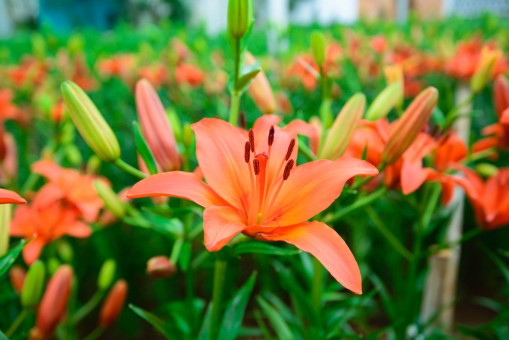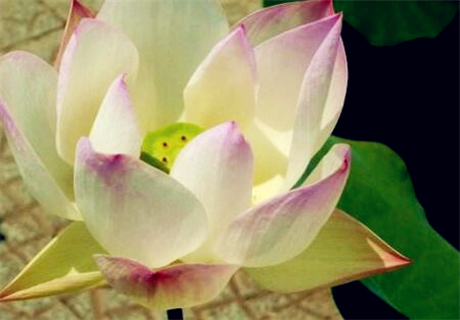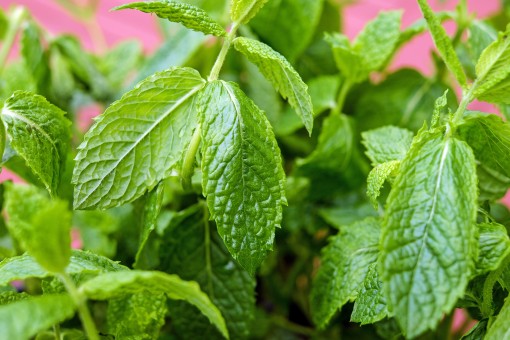Is cauliflower suitable for growing in dry land? What kind of variety should I plant? What is the time of planting and harvesting respectively?
Cauliflower, also known as Liliaceae, Hemerocallis, etc., is a common perennial herb of Liliaceae in China. It is used as a health vegetable because of its high nutritional value, tonifying blood, brain, anti-aging and so on. At present, it has been planted in most areas. Is it suitable for growing lily in dry land? What kind of variety should I plant? When is the planting time and harvest time respectively? How do you plant it?

Can dryland be planted?
Dry land can be planted, because cauliflower has developed roots, barren tolerance, strong adaptability, no matter flat land or hillside can be planted, in sandy loam, clay loam can grow normally, the soil requirements are not strict. Cauliflower is a perennial crop, which can be harvested continuously for more than 15 years after planting. In order to obtain high-yield and high-quality cauliflower, it is most suitable for Sichuan, plateau, platform, terrace and palm land with deep soil layer, fertile soil, flat terrain, good drainage and slope less than 15 °.
II. Variety selection
The existing varieties of cauliflower, such as Mengzi flower, April flower, white flower, Jingzhou flower, Chongli flower, Dawuizui and so on, all have the characteristics of strong disease resistance and high yield. Generally speaking, the yield of early-maturing and late-maturing varieties of cauliflower is lower, while that of middle-maturing varieties is higher, but because of its long harvest time, it is necessary to match early, middle and late-maturing varieties reasonably.
3. Planting techniques:
1. Cultivate strong seedlings
(1) ramet breeding method
Ramet propagation is the most commonly used propagation method of cauliflower, and there are generally two ways:
① dug up part of the plant on one side of the mother plant cluster to make seedlings, and the rest let it continue to grow.
② dug up all the mother clumps and replanted them. When digging and dividing seedlings, the roots should be hurt as little as possible, and the roots should be planted as soon as possible. After the seedlings were dug out, the soil was shaken off, and every 2 to 3 buds were divided into a clump or a plant, and the rotten roots, old roots and diseased roots growing in the lower part of the rhizome were cut off, leaving only 1-2 layers of new roots and about 10cm length.
(2) the method of raising seedlings by shortening stems and cutting pieces.
After the harvest of cauliflower, dig out the root plant, separate according to the bud piece, remove the dead leaf and hairy leaf around the short shrinking stem, leave the leaf length 3~5cm, cut off the upper end, and then cut the rhizome into 2 pieces longitudinally from top to bottom. If the rhizome is strong, it can be cut longitudinally. Generally, each plant can be divided into 2-6 plants, or even as many as 10 plants. Note that when cutting, each seedling piece should have a "seedling stem" and a fibrous root under it. After cutting, soak the seeds with 1200 times solution of carbendazim and disinfect for 1 h. After being exposed to the sun, mix the seeds with fine soil or plant ash mixed with loess to raise seedlings.
(3) seed propagation
The seed propagation method of cauliflower is fast and has a large number of propagation, which can provide seedlings for large-scale cultivation. During the growing period of cauliflower, do not harvest flowers. There are 10-50 full and fine seeds in each capsule. When the capsule changes from milky yellow to grayish black and the upper part is split, it can be harvested. The fully mature seeds are black and shiny, and the weight of 100 seeds is about 2g. In order to sow and raise seedlings with seeds, fertile land must be selected to make a small bed with a width of 1.0m to 1.2m, and the seedlings must be sowed from mid-late April to early June. Before sowing, first trench on the border surface, deep 3~5cm, according to row spacing 15cm, plant spacing 1cm sowing. After the seeds are sown, cover the soil slightly and cover the soil with a thickness of 2~3cm, which can be covered with plastic film to preserve soil moisture and increase temperature and promote the growth of seedlings. After the seedlings are unearthed, the film should be broken to prevent the seedlings from burning. After growing in the seedling bed for one year, the seedlings can be planted in the second year.
(4) planting
Cauliflower can be planted in all periods except in the full seedling stage and picking stage, but there are two most suitable planting seasons.
① spring (March to April), that is, the growth of cauliflower spring seedlings has just begun, at this time, the survival rate of propagation and planting is high, after one year of growth, the second year can enter the picking period.
② early autumn (September), cauliflower planted in early autumn can take root and grow seedlings, grow a large number of leaves and new root groups, absorb a lot of nutrients, carry out leaf bud differentiation, and lay a good foundation for the production of new tillers in the coming year.
The wide and narrow row planting method of cauliflower in dry land is generally adopted, such as wide row 120~140cm, narrow row 20~30cm, hole spacing 9~15cm, planting 1 plant per hole, so as to facilitate mechanical farming, ventilation and light transmission, and increase yield. When planting, the selected plots are trenched according to wide and narrow rows, ditch depth 12cm, wide 20cm, lily seedlings are arranged according to the prescribed plant spacing, artificial soil cover planting, soil cover depth 10cm, so that "the top is not capped, the root is not seen at the bottom". After covering the soil, cover the soil firmly with your feet so as to facilitate the full contact between the root system and the soil and promote rooting and sprouting.
2. Field management
(1) Management of planting seedlings
In the early stage of cauliflower seedling planting, if the soil moisture is poor, it should be properly watered to improve the survival rate. After the survival of the planted seedlings, the weeding should be ploughed in time to promote strong seedlings. The planted seedlings should be weeded 3 times in spring and 2 times in autumn.
(2) Management in spring and seedling stage
The period from seedling germination to bolting is called spring seedling stage, and the time is from March to May. The Beginning of Spring began to grow when the daily average temperature reached more than 5 ℃. With the increase of air temperature, the leaves grew rapidly, and each tiller could grow 16 to 20 leaves, which laid the foundation for reproductive growth. Fertilizer should be applied early in the spring seedling stage, and urea 500~600kg/hm2 should be applied on both sides of the seedling cluster after the spring seedlings turn green. At the same time, timely ploughing and weeding once, the depth of 10cm above.
(3) Management of bolting and budding stage.
The bolting period is from late May to mid-June. the primary flower stalk is pen-shaped, and the bud appears after it grows. After the bud is formed, it blooms gradually. At this time, topdressing should be done once, and Stanley compound fertilizer 400~500kg/hm2 should be applied in trenches on both sides of the seedling clump. At the same time, timely ploughing and weeding for once to loosen the soil and remove weeds.
(4) flowering stage management
The flowering period is the harvest time, and the time is from June to September. It can be harvested for 30 days and 60 days according to different varieties. In order to prolong the picking period and increase the yield, urea 75kg/hm2 was applied within 7-10 days after picking. During the picking period, 0.2% potassium dihydrogen phosphate aqueous solution was sprayed on the leaves every 7 days or so, which had an obvious effect on strengthening buds and preventing budding.
(5) Management in winter seedling stage
The growth period of winter seedlings is from the end of flowering to Frosts Descent, and the axillary buds in the lower part of flower bolts germinate and grow one after another, which are called winter seedlings. At this time, the photosynthetic organic matter of winter seedlings and other leaves are stored in fleshy roots and short stems for the growth of spring seedlings in the following year. Therefore, the growth of winter seedlings also affects the yield of the following year. At this time, we should plough and weed once, break the soil consolidation, improve the soil water storage capacity, protect leaves and increase the efficiency of photosynthesis.
(6) dormant period management
After Frosts Descent, all the aboveground leaves withered and entered the dormant period from October to March of the following year. At this time, the withered leaves should be cut, weeds should be removed, and the soil should be ploughed or rotated in time to make the soil deep, fine, flat, clean, virtual and solid, and the ground level. Combined with soil preparation, the winter seedlings of cauliflower were cultivated and obstructed to enhance their cold resistance.
(7) Rejuvenation
There are many rough and fat fleshy roots in the lower part of the area, and when the aboveground part tillers into dense clumps, it indicates that the plant of cauliflower needs to be renewed and rejuvenated.
Specific methods: after harvest, combined with large and medium ploughing in autumn, the old plant of 1 big 2 was dug up with roots on one side of each clump, and continued to propagate as seedlings to promote the whole plant to produce new tillers and sprout new roots. achieve the purpose of renewal and rejuvenation, and rejuvenate the other side with the same method after 3 years and 4 years.
3. Pest control
(1) Rust
Rust can occur in the whole growth period of cauliflower, which mainly harms leaves and stems. During the initial infection, there are blister spots, with the development of the disease, there are yellow-brown powder scattered, sometimes blister spots merge into one piece, the epidermis is rolled up, the blister spots are often green and yellowish, the whole leaves turn yellow, and in serious cases, the whole plant leaves die, and the flower stems turn reddish brown and the buds shrivel or fall off.
Prevention and control methods:
① fertilizes reasonably and drains water in time after rain to prevent stagnant water in the field or excessive surface humidity.
After ② harvest, bolting and leaf cutting are concentrated and burned, and the soil is turned in time.
③ loosening soil and weeding in early spring; fourth, in the early stage of the disease, spray control with 15% triadimefon wettable powder 500 times 600 times, or 20% triadimefon wettable powder 600 times 800 times, once every 7 days and 3 times in a row.
(2) Leaf blight
Leaf blight mainly harms leaves. There are round pale spots on the leaf tip during the initial infection. With the development of the disease, the leaves turn yellowish brown and dry along the edge. If the humidity is high, black mildew is produced.
Control method: spray with the 800-fold liquid of 75% chlorothalonil wettable powder, once every 7-10 days, a total of 2-3 times.
(3) Red spider
Red spiders are harmed by nymphs and adults on the back of the leaves, and there are gray-white spots in the injured areas. In severe cases, the whole leaves are gray-white, which eventually leads to death.
Control method: spray with 1500 times solution of 15% promethazine wettable powder or 73% propargite 2000 times solution.
(4) aphids
Aphids mainly occurred in May, first damaged leaves, and then gradually developed to flowers and buds, after being killed, the buds were thin and easy to fall off.
Control method: spray with 10% imidacloprid wettable powder 1000-1500 times, or 10% acetamiprid 1500-2000 times.
4. Picking
When the buds are yellowish green and full, the vertical furrows on the petals are obvious and are budding. If the buds are not fully expanded and the yield is low when harvested prematurely, the yield and quality will be affected if the buds are harvested too late. The best harvest time is 2 hours before flowering, which is generally 7-100-14-00, first ripe first, then ripe later.
5. Processing
(1) steaming
Steaming is a key process to determine the quality of dried cauliflower. The picked buds should be steamed in time. Before steaming, the blooming buds should be removed and steamed in multi-layer steamers. The layer should be fluffy, the thickness should be 6~10cm, and a small hole should be left in the middle to facilitate the rise of steam. The steaming temperature is 7580 ℃, the steaming time is 8 minutes, the maturity is 5 minutes, the color changes from yellow to green, the flower stalk begins to soften, and the buds are rubbed with hands.
(2) drying
After steaming, the buds are spread out thinly on the sun curtain, which is placed on the flower rack to make it aerial, so as to facilitate the distribution of water around. Generally, it takes 2 to 3 days to dry. Turn frequently when drying to prevent rain. The sun-dried cauliflower is not crispy to hold with your hands, and it is appropriate to let go and not stick to each other.
(3) Storage
After drying, cauliflower has a strong moisture absorption capacity, so it should be sealed in chemical fiber bags or plastic bags and stored in a dry and cool place.
Time: 2019-03-15 Click:
- Prev

Etiquette flower perfume lotus (nine grades of perfume lotus) the price can be sold for 10 yuan! What are the planting prospects?
Friends who like flowers must know the perfume lotus, also known as the nine-grade perfume lotus, because it can produce gold, yellow, purple, blue, red, tea, green, red and white flowers, and the lotus is often called a holy thing. So how much is the lotus perfume? What are the planting prospects? Brief introduction of perfume lotus flower
- Next

What kind of Yindan mint is good? When will you plant it? When will it be picked? How do you plant it?
Peppermint, also known as Yindan grass and night incense, is a common Labiatae plant in the south of the Yangtze River. it is widely planted because it is both edible and medicinal.
Related
- Fuxing push coffee new agricultural production and marketing class: lack of small-scale processing plants
- Jujube rice field leisure farm deep ploughing Yilan for five years to create a space for organic food and play
- Nongyu Farm-A trial of organic papaya for brave women with advanced technology
- Four points for attention in the prevention and control of diseases and insect pests of edible fungi
- How to add nutrient solution to Edible Fungi
- Is there any good way to control edible fungus mites?
- Open Inoculation Technology of Edible Fungi
- Is there any clever way to use fertilizer for edible fungus in winter?
- What agents are used to kill the pathogens of edible fungi in the mushroom shed?
- Rapid drying of Edible Fungi

